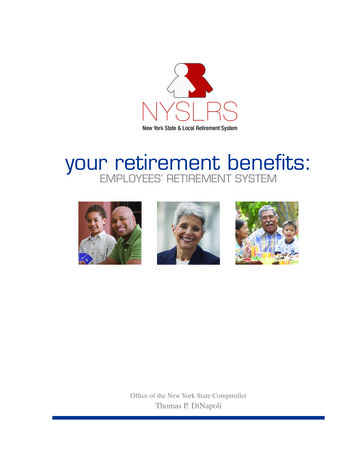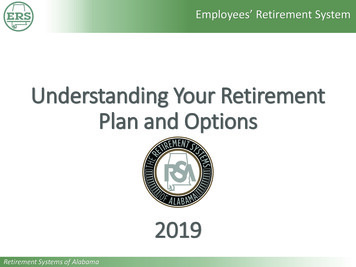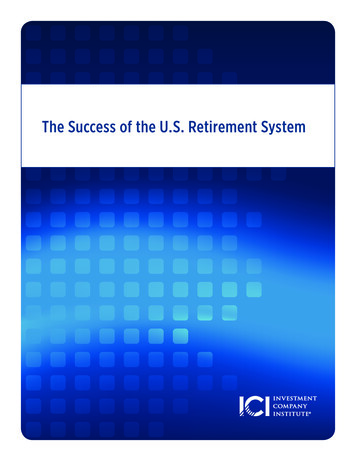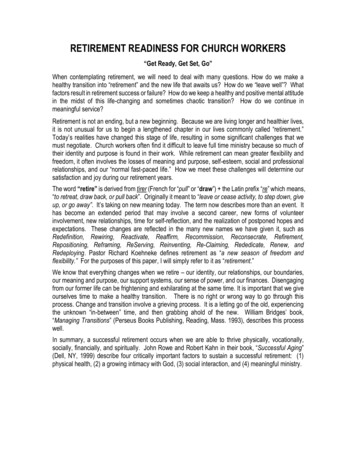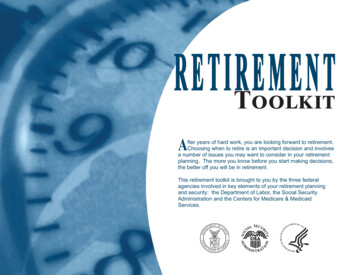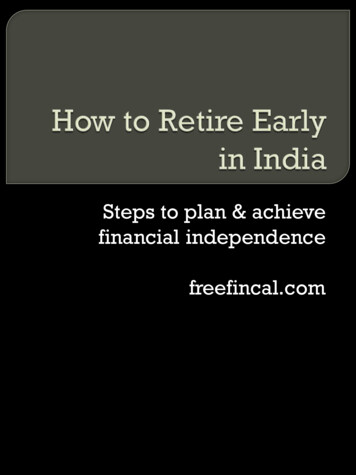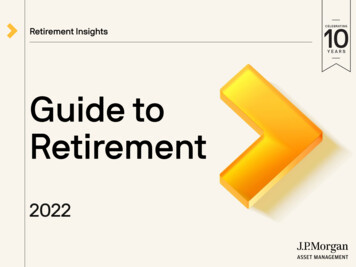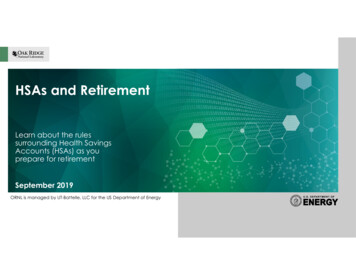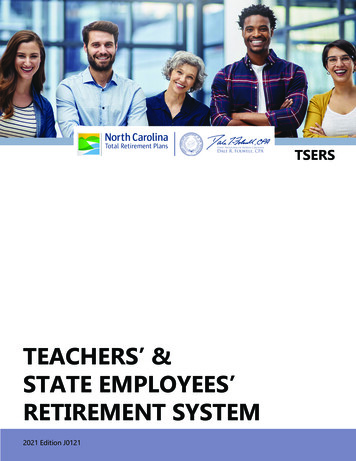
Transcription
TSERSTEACHERS’ &STATE EMPLOYEES’RETIREMENT SYSTEM2021 Edition J0121
22021 Edition J0121
Welcome to the Teachers’ and State Employees’ Retirement System!The Teachers’ and State Employees’ Retirement System (TSERS) is a pension planadministered by the North Carolina Total Retirement Plans within the Department of StateTreasurer (DST). Here, our mission is to preserve and protect this benefit for current andfuture public employees in North Carolina.You have chosen a career to serve the citizens of North Carolina; therefore, you are acontributing member to one of the best funded in the nation. In fact, Moody’s InvestorsService recently reported that North Carolina’s Retirement Systems, which includes stateand local employees, is the best funded in the nation when looking at its Adjusted NetPension Liability.Partners in Planning for Your RetirementWe are proud to partner with you during and after your service to North Carolina. Your monthly contribution of6% to the North Carolina pension, along with employer contributions, on average 13% across all systems, andinvestment returns, create a foundation for your future in retirement.Our role is to maintain the integrity and sustainability of the North Carolina Retirement Systems. Your role is tomake sure you’re doing all you can to secure your financial future. Your employer and the pension system areinvesting a lot in you because your work to this state is highly valued!When planning for a secure retirement, I encourage you to determine how much retirement income you’ll needto feel secure after you stop working. As you make that determination, you should not only consider your TSERSbenefits, but also your Social Security benefit and personal savings.Supplemental Savings Exclusively Available to YOUThe NC 401(k) and NC 457 Plans and the NC 403(b) Program are exclusively available to public servants likeyou. These plans are also recognized nationwide for low fees and diverse, strong-performing investments andmeaningful oversight by the Board of Trustees. These benefits are available not only while you are working andactively participating, but can continue into retirement. And, you have the option to keep your money in plans forthe rest of your life.Understanding Your Pension BenefitIn this handbook you’ll find all the details you need to understand your retirement options. You’ll also find many ofthe tools and resources you need to make informed decisions about your retirement on ORBIT, our secure webportal, at ORBIT.myNCRetirement.com. Once you’ve registered, you’ll be able to safely and securely manageyour account, track service credit, investment returns, maintain beneficiaries and personal information, and stayinformed. Additional resources are also available at myNCRetirement.com.We have a team of retirement counselors ready to assist if you have questions about benefits or need guidance asyou near retirement.Thank you for your service to North Carolina, and we look forward to working with you now and through yourretirement!Sincerely,1-877-NC-SECURE (877-627-3287)nc.retirement@nctreasurer.comDale R. Folwell, CPAwww.myNCRetirement.comTSERS myNCRetirement Benefits HandbookTeachers’ & State Employees’ Retirement System3
Table of Contents myNCRetirement Benefits HandbookTeachers’ & State Employees’ Retirement SystemSection 1 About Your Retirement SystemSection 2 Membership in TSERS7 Designating beneficiaries7 Forfeiting Eligibility based on Criminal OffensesSection 3 Qualifying for Benefits8 Vesting8 Service Retirement (Unreduced benefits)8 Early Retirement (Reduced benefits)8 Vested Deferred Benefit9 Refund of Contributions9 Reciprocity Between Retirement Systems9 Transferring Service & Contributions9 Required Distributions After Age 72Section 4 How Your Benefit is Calculated10 Retirement Formula11 Service Retirement Calculation Example12 Early Retirement Calculation Example12 Early Retirement Reduction Percentages13 Examples of Monthly Benefits Paid14 Benefit LimitationsSection 5 Your Benefit Payment Options15 Your Benefit Payment Options18 Example of Payment OptionsSection 6 Adding to Your Creditable Service19 Adding to Your Creditable ServiceSection 7 NC 401(k) Plan, NC 457 Plan,NC 403(b) Program21 NC 401(k) and NC 457, NC 403(b) ProgramSection 8 Initiating Your Retirement Benefits22 Retirement Application Process23 Your First Monthly Benefit23 Post-Retirement IncreasesDISCLAIMER: The availability and amount of all benefits you might be eligible to receive is governed by North Carolina law. The information provided in this handbookcannot alter, modify or otherwise change the controlling North Carolina law or other governing legal documents in any way, nor can any right accrue to you by reason ofany information provided or omission of information provided herein. In the event of a conflict between this information and North Carolina law, North Carolina law governs.42021 Edition J0121
Table of Contents myNCRetirement Benefits HandbookTeachers’ & State Employees’ Retirement System15Section 12 Disability Benefits31 Disability Income Plan of North Carolina (DIPNC)31 TSERS Disability BenefitSection 9 Income Tax24 Income Tax (Benefits)25 Income Tax (Returns, Purchases and Refunds)Section 13 Death Benefits32 Active Employee Death Benefits33 Retiree Death BenefitsSection 10 Health Coverage in Retirement26 State Health Plan27 Optional Supplemental InsuranceSection 14 Administration & Funding34 Administration & FundingSection 11 Returning to Work after Retirement28 The Required Six-Month Break Guidelines28 Six-Month Break in Service Required29 Working After a Six-Month Breakwith a TSERS Membership28 Working After a Six-Month Breakwithout a TSERS Membership30 Exceeding Your Earnings Limitations30 After Receiving Disability30 Effects on Health CoverageSection 15 Resources & Contacts36 ORBIT37 Web-based Resources37 Contact UsSection 16 Glossary of Important TermsSection 17 AddendumAre you a Law Enforcement officer in the Teachers’ and State Employees’ Retirement System?Please refer to the TSERS LEO Handbook for your benefits.TSERS myNCRetirement Benefits HandbookTeachers’ & State Employees’ Retirement System5
Section 1 About Your Retirement SystemThe Teachers’ and State Employees’ Retirement System (TSERS) is a definedbenefit plan qualified under Section 401(a) of the Internal Revenue Code.Defined benefit plans use a formula to calculate monthly retirement benefitsonce eligibility requirements have been met. This handbook explains TSERSbenefit eligibility requirements and the formula used to calculate benefits.Terms in bold type are defined in Section 15 – Glossary of Terms.PAYING FOR YOUR RETIREMENT BENEFITSYou, the state of North Carolina and the investment earnings on totalcontributions pay the cost of providing your retirement benefits.Your share of the cost is currently six percent of your compensation, and it isautomatically deducted from your paycheck. Your compensation includes alleligible salaries and wages, as defined by statute, paid to you from public funds,earned at your covered job while working for the state.The state bases its contributions on calculations prepared by an actuary. Thestate contribution rate from July 1, 2018, to June 30, 2019, is 18.86 percent of allmembers’ salaries to pay for the benefits for you and other members.TAX SAVINGSSince July 1, 1982, your contributions have been tax-deferred. This means yourcontributions are deducted from your pay before taxes are calculated, and youpay taxes on them when you begin receiving monthly retirement benefits or if youelect a refund of your contributions. This is a benefit to you because your currenttaxable income is lowered and the amount of annual taxes you pay is less than ifyou made contributions after paying taxes. See pages 24-25 for more informationabout your tax liability on benefits.INVESTING CONTRIBUTIONSContributions to TSERS are invested by the Department of State Treasurer and these funds are protected bythe Constitution of North Carolina from being used for any purpose other than retirement system benefits andexpenses.ORBIT ONLINE ACCOUNT ACCESSORBIT is a secure site that allows you to view yourpersonal account information, download retirementforms, and access retirement resources 24 hours a day,seven days a week.To set up or log in to your personal ORBIT account, go tothe ORBIT website at ORBIT.myNCRretirement.com andfollow the log in instructions, or register for an ORBITaccount. See page 35 for more information about ORBIT.62021 Edition J0121When creating your account, use your personalemail address.If you already have an account and use your workemail, we recommend logging in and changing thisto your personal email so you will continue to haveaccess to your account should you switch jobs orretire.
Section 2 Membership in TSERSMembership in TSERS is automatic for eligible employees. You become a TSERS member on your hire date if youare: A permanent full-time teacher or employee of a state-supported board of education or community college. A permanent employee of the state (or any of its agencies, departments, bureaus or institutions) and workat least 30 hours per week for nine months per year. A permanent employee of a charter school that participates in TSERS, and you work at least 30 hours perweek for nine months per year.You may join an optional retirement program instead of TSERS if you are: A faculty member, administrator or other eligible employee at a state institution of higher education An eligible employee of UNC Health Care A community college presidentIf you are an Agricultural Extension Service employee and a member of the Federal Employees’ Retirement System,you may not join TSERS. Contact your employer for more details about the alternate systems.DESIGNATING BENEFICIARIESAfter your employer enrolls you in TSERS, and within one to two payperiods, you should be able to create your secure ORBIT account and namebeneficiary(ies) to receive a return of your retirement contributions and, ifapplicable, a death benefit, should you die before retirement. A memberhas the option to name any person as their beneficiary regardless ofrelationship to member (ie the beneficiary does not have to be a spouse orfamily member). To add or change beneficiaries as an active employee: Log in to ORBIT Click the Maintain Beneficiaries tab on the left side of the screen Add or edit beneficiaries for your eligible benefits Perform a beneficiary check-up every couple of years or if you have alife-changing event, such as marriage, divorce, family changes or adoptions.FOREFEITING ELIGIBILITY BASED ON CRIMINAL OFFENSESIf you were not vested as of December 1, 2012, and are convicted of a state or federal felony directly related toyour employment while in service under TSERS, you are prohibited from receiving any retirement benefit otherthan a return of your contributions plus interest.If you were vested as of December 1, 2012, you are prohibited from receiving any retirement benefit for servicerendered after December 1, 2012, other than a return of your contributions plus interest for the period of serviceafter December 1, 2012.Elected government officials who were not vested on July 1, 2007, will forfeit their right to a monthly benefitfrom TSERS if convicted of certain state or federal offenses related to their service as an elected official.Elected officials who were vested on July 1, 2007, are not entitled to creditable service accrued in TSERS afterJuly 1, 2007, if convicted of certain state and federal offenses related to their service as an elected official.TSERS myNCRetirement Benefits HandbookTeachers’ & State Employees’ Retirement System7
Section 3 Qualifying for BenefitsVESTINGYou become vested in TSERS once you have completed a minimum of fiveyears of creditable service. This means that you are eligible to apply for lifetimemonthly retirement benefits based on the retirement formula in effect at thetime of your retirement and the age and service requirements described in thishandbook, provided you do not withdraw or transfer your contributions. You mayalso be eligible for retiree health coverage. See page 28 for more information onhealth coverage.SERVICE RETIREMENT (UNREDUCED BENEFITS)You may retire with an unreduced service retirement benefit after you: Reach age 65 and complete five years of membership serviceReach age 60 and complete 25 years of creditable serviceComplete 30 years of creditable service at any ageEARLY RETIREMENT (REDUCED BENEFITS)You may retire early with a reduced retirement benefit after you: Reach age 50 and complete 20 years of creditable serviceReach age 60 and complete five years of membership serviceYour early retirement benefit is calculated using the same formula as a serviceretirement benefit multiplied by a reduced percentage based on your age and/or service at early retirement. Because your benefit may be paid over a longerperiod of time than if you had waited until being eligible for service retirement,your benefit will be reduced. The tables on pages 12 and 13 show the effectsthese reductions would have on your benefit.VESTED DEFERRED BENEFITIf you leave TSERS for any reason other than retirement or death, you can either receive a refund of yourcontributions, plus interest, or leave your contributions in TSERS and keep all the creditable service you earned tothat date. You may be entitled to receive a deferred benefit at a later date once you meet eligibility requirementsafter you have completed five years of creditable service, provided you do not withdraw your contributions.Your benefit is calculated using the formula in effect on your retirement date. It is based on your average finalREFUND OF CONTRIBUTIONSHowever, if you leave TSERS employment and you donot take a refund, you will retain your benefits andrights should you return to TSERS service at a latertime.State law prohibits us from making a refund earlierthan 60 days after you leave employment with anemployer that participates in TSERS.Set by state law, the interest credited on yourcontributions and paid with a refund is 4 percentcompounded annually on your prior-year endingbalance.If you leave TSERS before you have five years ofcreditable service, the only payment you can receive isa refund of your contributions and interest.If you withdraw your retirement contributions,you forfeit your retirement service credit andrights to all benefits associated with the servicefor that time period, including medical coverage8 through the State Health Plan, if applicable.To receive a refund, complete Form 5 (Withdrawing YourRetirement Service Credit and Contributions).
Section 3 Qualifying for BenefitsRECIPROCITY BETWEEN SYSTEMSAny credit you may have in the following retirementsystems may be counted along with your credit inTSERS in order to determine your eligibility for areduced or unreduced benefit: Legislative Retirement System (LRS)Consolidated Judicial Retirement System(CJRS)Local Governmental Employees’ RetirementSystem (LGERS)However, only your creditable service in TSERS is usedin computing the amount of your benefit in TSERS.Creditable service in any other system is used tocompute benefits from that system.In addition, for members first hired prior toJanuary 1, 2021, any service credit you have in theUNC Optional Retirement Program may be added toyour creditable service in TSERS in order to determineeligibility for benefits from TSERS.TRANSFERRING SERVICE &CONTRIBUTIONS BETWEEN SYSTEMSYou can transfer your contributions and creditableservice between TSERS and LGERS as long as youare an eligible member of the system to which youare transferring, do not receive a refund of yourcontributions from the system from which you aretransferring and file Form 5TR (Transferring Service andContributions Between Systems), available in ORBIT.Transferred creditable service counts toward youreligibility for a monthly benefit and is used tocompute the amount of your benefit. Overlappingtransferred service cannot be counted twice for thesame time period.A transfer can affect your eligibility for State HealthPlan coverage under the Retirement Systems. Formore information about the State Health Plan, seepage 27.After completing five years of membership service inTSERS, you may transfer contributions and creditableservice from CJRS and LRS to TSERS. Contact us foradditional information and instructions.The general rules for eligibility for transfer are as follows: You may transfer to the System that retains your latest service andcontributions if the law allows the latest System to receive the transfer. Your latest System may have further requirements for eligibility.Visit myNCRetirement.com formore information about Reciprocity.REQUIRED DISTRIBUTIONS AFTER AGE 72In most cases, TSERS is required to pay benefits to non-retired members with open TSERS accounts by April1 of the year following the year in which the member reaches age 72 or ceases to be an employee, whicheveris later.Members who are vested (five or more years of creditable service) who fail to complete the retirementprocess will receive a monthly retirement benefit based on the maximum allowance.Non-vested members who fail to complete a refund application will receive a refund of their contributionsand interest by April 1 of the year following the year in which the member reaches age 72.TSERS myNCRetirement Benefits HandbookTeachers’ & State Employees’ Retirement System9
Section 4 How Your Benefit is CalculatedRetirement Formula:Your annual benefit 1.82%of average final compensationxyears and monthsof creditable serviceAVERAGE FINAL COMPENSATION is the average of your salary during your four highest-paid years(48 consecutive months) in a row. If your four highest-paid years in a row include a final payment for unusedvacation leave and/or prorated longevity, your average final compensation may be increased by the extrapayment(s). Final payments, if any, for unused sick leave or reimbursements for expenses are not includable inyour average final compensation.CREDITABLE SERVICE is the total of all service credit that counts toward retirement. It includes membershipservice for any period you contribute to TSERS, provided you have not withdrawn your contributions. It alsoincludes credit for eligible purchased service and eligible unused sick leave that is converted to creditable serviceat retirement. See pages 19-20 for more details.SERVICE RETIREMENT CALCULATION EXAMPLEAssume employee Mary Benson retires at age 60 with 32 years and two months of creditable service and anaverage final compensation of 40,331. Because Mary has more than 30 years of creditable service at retirement,she receives her basic benefit of about 24,000 a year (about 2,000 monthly) for the rest of her life under themaximum allowance. Monthly payments would stop at her death.102021 Edition J0121
Section 4 How Your Benefit is CalculatedThe following table shows how we calculate Mary’s benefit. Use the spaces in the right-hand column to fill inyour figures for an estimate of your benefit.Step 1Add your salary during your4 highest-paid years (48 months) in a rowThen, divide the total by 4 to getyour average final compensationStep 2Multiply Step 1 by .0182to apply the retirement formula*(see page 10)YouexampleYear 1 39,988Year 2 40,484Year 3 41,350Year 4 41,994Total 163,816Average FinalCompensationStep 1 40,954 40,954x .0182Total 32.2 yearsDetermine your creditable service(see page 19)Calculate your annualbenefit* by multiplyingStep 2 by Step 3Step 5Calculate yourmonthly benefit* bydividing Step 4 by 12x .0182 745.36Step 3Step 4/ 4divide by 4Step 2 Step 3TotalAnnualBenefitStep 4 745.36xx 24,000.68 24,000.68divide by 12TotalMonthlyBenefit32.2 / 12 2,000.06(This is an estimate of the payment you will receive eachmonth before taxes or any other deductions.)*Remember, if you retire early or if you choose for payments to continue to a beneficiary after your death,these numbers will change. See next page for how to calculate early retirement amounts.TSERS myNCRetirement Benefits HandbookTeachers’ & State Employees’ Retirement System11
Section 4 How Your Benefit is CalculatedIf you are between ages 50 and 59, with fewer than 30 years of creditable service, your early retirement will bereduced to the percentages shown in the table on below.If you are a firefighter or rescue squad worker between age 55 and 60 with five to 20 years of creditable service, yourearly retirement will be reduced to the percentages shown below in the 20 years of creditable service column.AgeYears of Creditable 0%55%55%55%55%55%80%75%70%65%60%55%52%50%50%50%The chart above uses whole numbers for years of service and age as a reference. When you retire, yourcreditable service will be adjusted based on age and service in years and months.EARLY RETIREMENT REDUCTION PERCENTAGESYour age at retirement is an important factor in determining your monthly benefit.If you do not meet therequirements for a full-service retirement, you may still retire early, but you will receive a reduced monthlybenefit for your lifetime.Early retirement benefits are calculated using the same formula as a service retirement multiplied by areduction percentage based on your age and/or service at early retirement. If you are between ages 60 and65, with less than 25 years of creditable service, your early service retirement benefit will be reduced to thefollowing percentages. If you are between birthdays when payments start, the reduction will be adjustedproportionately.If you are this agewhen payments startYou receive this percentageof your benefit64. . . . . . . . . . . . . . . . . . . . . .63 . . . . . . . . . . . . . . . . . . . . . . .62 . . . . . . . . . . . . . . . . . . . . . . .61 . . . . . . . . . . . . . . . . . . . . . . .60 . . . . . . . . . . . . . . . . . . . . . . .122021 Edition J012197%94%91%88%85%
Section 4 How Your Benefit is CalculatedEARLY RETIREMENT CALCULATION EXAMPLEAssume employee Fred Wise retires at age 61 with 24 years and three months of creditable service and an averagefinal compensation of 40,954.Here is how we calculate this benefit x x 40,954.00.0182745.3624.2518,074.98(average final compensation)Now apply the early retirementreduction percentage from page 12. x (creditable service)18,074.98(percentage at.88 age 61)15,905.98Fred receives a benefit under the maximum allowance of about 15,905 a year (about 1,325 monthly). Hispayment will start at age 61 and continue for the rest of his life.Assume, however, that Fred is age 59 instead of age 61. With 24.25 years of creditable service, his early serviceretirement reduction percentage is 0.80 instead of 0.88. In this case, Fred receives a benefit under the maximumallowance of about 14,460 a year (about 1,205 a month). His payment will start at age 59 and continue for therest of his life.EXAMPLES OF BENEFITS PAIDThe following chart shows the approximate monthly benefit paid under the maximum allowance option atvarious salary levels, depending on age and creditable service. These are only examples. Your own benefit iscalculated individually and depends on your age, creditable service and average final compensation.Monthly Retirement Benefit Under Maximum AllowanceAverage Final CompensationAgeYrs. of Service ,00030,0005020 ny40 3,4383,0572,6752,2932,1021,9111,7191,5281,3371,146 3,4113,0332,6542,2752,0851,8951,7061,5161,3271,137 4,0953,6403,1852,7302,5022,2752,0471,8201,5921,365 TSERS myNCRetirement Benefits HandbookTeachers’ & State Employees’ Retirement System13
Section 1:Section 4 How Your Benefit is CalculatedBENEFIT LIMITATIONSOccasionally, a retiree may be subject to the benefit limitations described below:CONTRIBUTION-BASED BENEFIT CAP (CBBC)As a member of TSERS, you contribute six percent of your monthly incometoward your retirement. If you receive significant salary increases in the yearsbefore retirement or over the course of your career, your monthly retirementbenefit at retirement may exceed what your contributions would be expectedto fund. Significant late-career promotions, conversion of benefits intocompensation, and leave payouts at retirement may also cause your monthlyretirement benefit to exceed what your contributions would be expected tofund. The Contribution-Based Benefit Cap was created to protect this systemfor current and future retirees, by providing a method for the payment of theseunforeseen costs.If you retire on or after January 1, 2015, with an average final compensation(AFC) of 100,000 or more (adjusted annually for inflation), you may fall under acontribution-based benefit cap.If you were first hired before January 1, 2015, your last employer will be requiredto pay the additional contribution if it is determined that your allowance is inexcess of the cap and is subject to an adjustment. TSERS will notify your employerand will provide a statement of the cost of the additional contribution required topay for your benefit in excess of the cap.If you were first hired on or after January 1, 2015, your employer may choosewhether or not to pay this additional contribution; if your employer choosesnot to pay, you will be required to accept a benefit reduced to the benefit capunless you pay the additional contribution. TSERS will notify you and will providea statement of the cost of the additional contribution required to pay for yourbenefit in excess of the cap, along with the deadline to submit payment.IRC SECTION 415(B) ANNUAL PENSION BENEFIT LIMITIf you are a highly compensated employee, yourTSERS benefits may be subject to the InternalRevenue Code (IRC) section 415(b) annual pensionbenefit limit. The determination of whether yourretirement benefit will be subject to the limit can onlybe made at retirement. The limit varies every year,so, your benefit could be affected one year but notthe next. The limit varies each year and is set by theIRS. The limit is affected by many factors that wereestablished by the IRS that may or may not apply to aparticular individual.142021 Edition J0121The General Assembly established a Qualified ExcessBenefit Arrangement (QEBA) fund to pay the part of aretiree’s retirement allowance that exceeds the limit.Members hired prior to January 1, 2015, are eligible toreceive benefit payments from the QEBA fund.For up-to-date information on benefitlimitations, including the Annual PensionBenefit Limit and the Contribution-BasedBenefit Cap, visit www.myNCRetirement.com.
Section 5 Your Benefit Payment OptionsAt retirement, you must elect one of the payment options described on page 16. On average, the paymentoptions are mathematically equal to one another from the perspective of TSERS, based on assumptionsrecommended by actuaries. Each option is calculated so its total value is the same as the value of the otheroptions available to you and the beneficiary you name (if any). The monthly payment amounts will differ basedon the age of the beneficiary you select, if any.CONSIDERING YOUR OPTIONSFirst, decide whether you need a payment option that provides a monthly benefit to a beneficiary after yourdeath. If you do not select one of these options, all of your retirement benefits will be used to provide you witha lifetime monthly payment that stops at your death.Your choice of payment options is personal and should take into account your needs during retirement and theneeds of a dependent, if any, after your death. Neither the payment plan selected by a co-worker nor the oneselected by the largest number of retirees should have any effect on your personal decision.PERMANENT DECISIONYou cannot change your selected payment option once you cash your first retirement check or after the 25thof the month following the month your first check is mailed (whichever is earlier) except under one of thefollowing two conditions: If you select an option that provides a monthly benefit to your spouse as a beneficiary after your death(Option 2, 3, 6-2 or 6-3) and later become divorced from that spouse. If you are rehired in a position covered by TSERS and contribute to your new account for at least threeyears.TSERS myNCRetirement Benefits HandbookTeachers’ & State Employees’ Retirement System15
Section 5 Your Benefit Payment OptionsHere are your benefit payment options:MAXIMUM ALLOWANCEWhen you retire with a service retirement benefit, your basic benefit is themaximum allowance and is calculated under the formula on page 10.If you retire early, your maximum allowance is calculated using the sameformula, which is then reduced for early retirement. In either case, you willreceive your allowance for as long as you live. All monthly payments stop atyour death.OPTION 2: 100% JOINT & SURVIVOR You receive reduced monthly payments for life. After you die, your monthly survivor beneficiary receives the same amount monthly for life.OPTION 3: 50% JOINT & SURVIVOR You receive reduced monthly payments for life which are slightly larger than the payments in Option 2. After you die, half of your payment continues to your monthly survivor beneficiary for life.OPTION 6-2:MODIFIED JOINT & SURVIVOR (combination MAX Allowance, Option 2) You receive reduced monthly payments for life (a large
In this handbook you’ll find all the details you need to understand your retirement options. You’ll also find many of the tools and resources you need to make informed decisions about your retirement on ORBIT, our secure web portal, at ORBIT.myNCRetirement.com. Once you’ve
